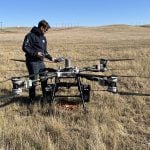
Tag Archives agricultural research

Farm-facing drone does the heavy lifting
The AGRAS T100 drone helps streamline a variety of jobs that are required on Prairie farms

Bioreactors in tiled fields could themselves benefit from draining
Bioreactors are meant to filter nitrogen from tile water to help with runoff nutrient loads, but drying them out from time to time might increase their effectiveness

Taking dairy wastewater to the irrigation pivot, via wetlands
A new nature-based solution could help dairy farmers in Alberta against water shortages

Herbicide researchers pick new fights
Different modes of action may overcome a lull in herbicide discovery

Editor’s Rant: Lights out
Thoughts on green policy-making ahead of Justin Trudeau's departure

Crop Production Show 2025: Ag research sector has productivity problem: panellists

Stubble height can make yield difference
Under extremely dry growing conditions, do your best to manage the moisture that’s there

Nominations open for international Women in Ag Award
Women who’ve made an exceptional contribution to the industry can be nominated

It pays to adjust seeding rate based on moisture
Keep wheat plant count in line with moisture expectations — and limit the amount of tillering

Teasing out the social angle of sustainable ag research
Recently funded network to bring together social scientists, agriculture and community groups


